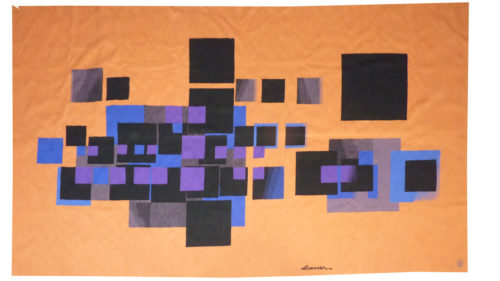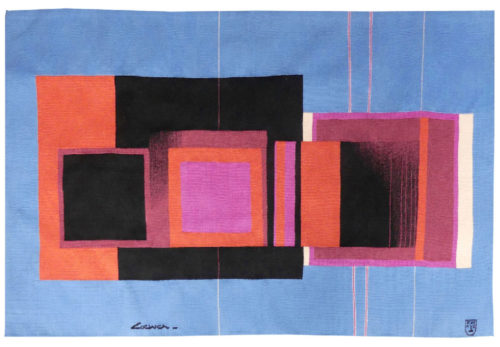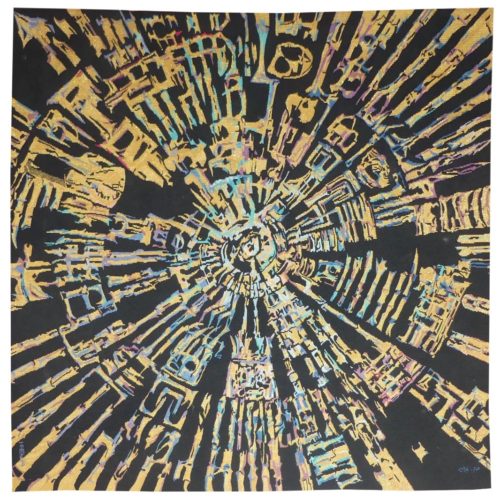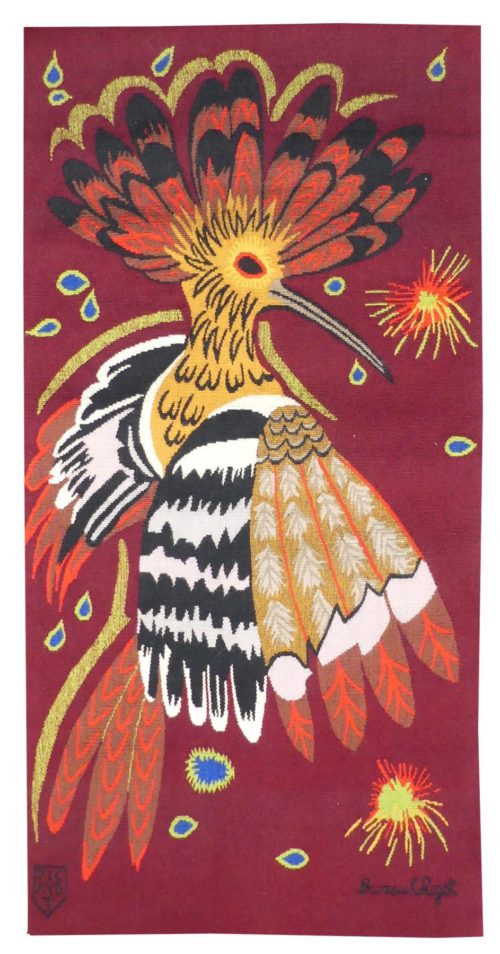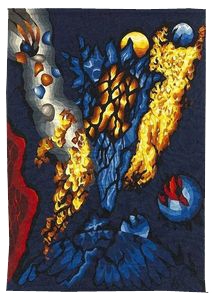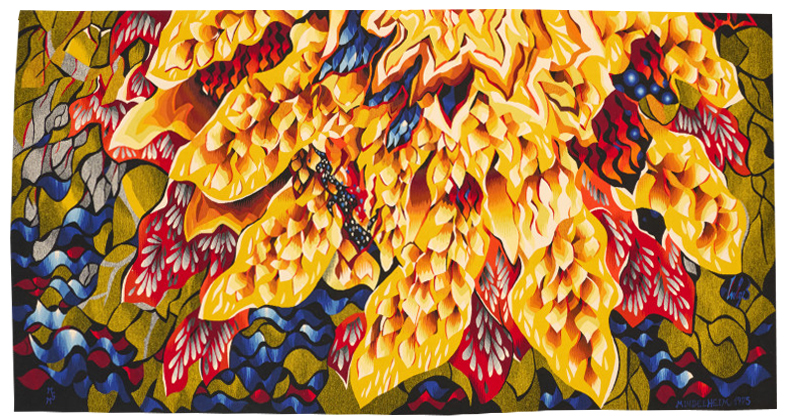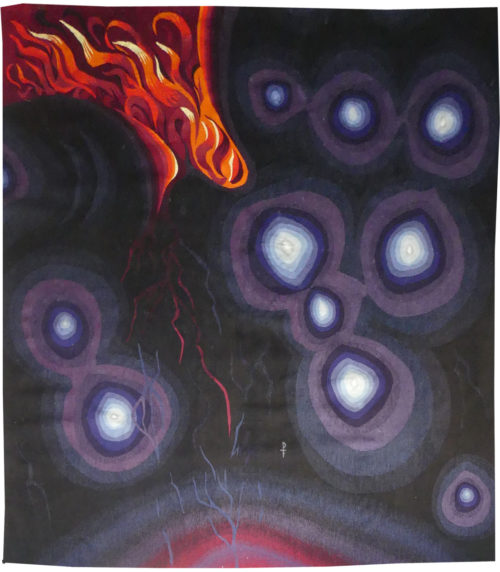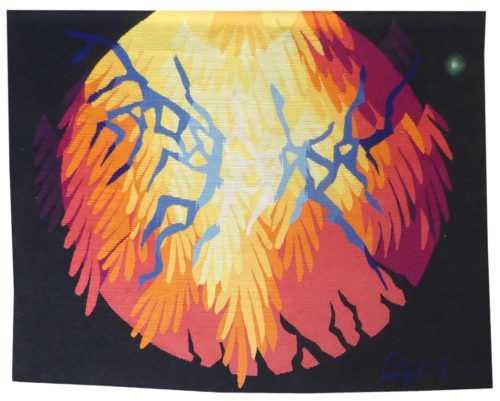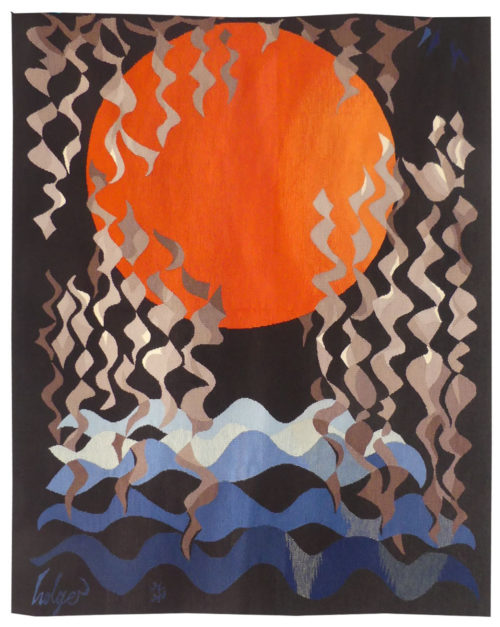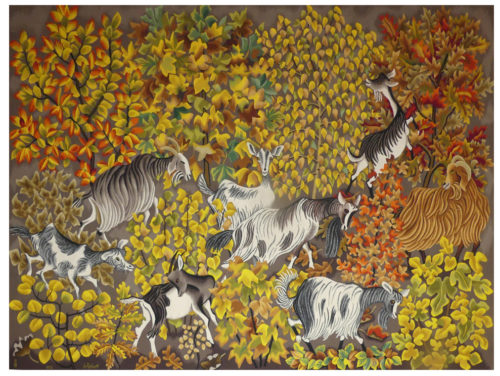-
Argos
Aubusson tapestry woven by the Picaud workshop. Complete with signed certificate of origin, n° 1/4. 1971. Loewer designed his first cartoon in 1953 ; his early works are first figurative before turning to abstraction (like Matégot) which is exclusively geometric in Loewer’s case. He designed over 180 cartoons, most of which were woven by his friend, Raymond Picaud. Around 1971-1972, Loewer’s style became more refined, with fewer geometric squares and a brighter, more contrasted use of colour. As is often the case with Loewer, this is a one-off piece. Bibliography : Claude Loewer, l’évasion calculée : travaux de 1939 à 1993, catalogue raisonné des tapisseries de 1953 à 1974, Sylvio Acatos, Charlotte Hug, Walter Tschopp and Marc-Olivier Wahler, Artcatos, 1994, n°128 -
Tapestry woven by the Braquenié workshop. With label, n°1. Circa 1975.A rare example of this artist’s work for the loom : in it we find his characteristically complicated formal arrangements.
-
La huppe rouge (the red hoopooe)
Aubusson tapestry woven by the Picaud workshop. With signed label, n°3/6. Circa 1970.Originally from the Limousin region of France (and the daughter of the master glass-blower François Chigot), Delphine Bureau-Chigot devoted a large part of her creative energies (she was also a painter and a pastel artist) to tapestry design (something over a hundred) which were for the most part woven by the Picaud workshop, often evoking a dream-like world where animals (and notably birds) had an important place. -
Holger was a student at the Ecole Nationale d’Art Décoratif d’Aubusson and worked with Lurçat before the latter’s death in 1966. He designed numerous dream-like cartoons woven by the Aubusson workshop. Now settled in the United States, he remains a tireless advocate for, and witness to, modern tapestry design, organising exhibitions and lectures on the subject.
Kosmische Vision (Cosmic vision)
Aubusson tapestry woven in the Pintron frères workshop. With certificate of origin. Circa 1970. -
Sonnen-Vision (Suns-Vision)
Tapestry woven by the Münchener Gobelin Manufaktur. With signed label. 1975.Holger was a student at the Ecole Nationale d’Art Décoratif d’Aubusson and worked with Lurçat before the latter’s death in 1966. He designed numerous dream-like cartoons woven by the Aubusson workshop. Now settled in the United States, he remains a tireless advocate for, and witness to, modern tapestry design, organising exhibitions and lectures on the subject. Some of his cartoons have been woven in the two workshops active in Germany, in Nuremberg and Munich, using Aubusson techniques. -
Holger was a student at the Ecole Nationale d’Art Décoratif d’Aubusson and worked with Lurçat before the latter’s death in 1966. He designed numerous dream-like cartoons woven by the Aubusson workshop. Now settled in the United States, he remains a tireless advocate for, and witness to, modern tapestry design, organising exhibitions and lectures on the subject.
Feu pour Law (Fire for Law)
Aubusson tapestry woven in the Pintron frères workshop. With signed certificate of origin, n°1/6. Circa 1970. -
Soleil pour Maria Pia (Sun for Maria Pia)
Aubusson tapestry woven by the Pinton workshop. With label, n°1/3. Circa 1970. Holger was a student at the Ecole Nationale d’Art Décoratif d’Aubusson and worked with Lurçat before the latter’s death in 1966. He designed numerous dream-like cartoons woven by the Aubusson workshop. Now settled in the United States, he remains a tireless advocate for, and witness to, modern tapestry design, organising exhibitions and lectures on the subject. -
Nachtsonne (Nightsun)
Tapestry woven by the Münchener Gobelin Manufaktur. With signed label. Circa 1970.Holger was a student at the Ecole Nationale d’Art Décoratif d’Aubusson and worked with Lurçat before the latter’s death in 1966. He designed numerous dream-like cartoons woven by the Aubusson workshop. Now settled in the United States, he remains a tireless advocate for, and witness to, modern tapestry design, organising exhibitions and lectures on the subject. Some of his cartoons have been woven in the two workshops active in Germany, in Nuremberg and Munich, using Aubusson techniques. -
Chèvrefeuilles (Honeysuckle/Goats and leaves)
Aubusson tapestry woven in the Goubely workshop. With signed label, n°1. 1973. A Benedictine monk and an illuminator, Dom Robert met Jean Lurçat in 1941 at the Abbey of En Calcat : while he never abandoned drawing (his watercolours, painted to life, would serve him as a reservoir of ideas for his tapestries), his work as a cartoonist (he was a member of the A.P.C.T. from its inception) would take on a considerable importance (at least a hundred cartoons, all numbered) and would be highly thought of. His immediately recognisable style, absence of perspective¸motifs inspired from the natural world (in a Paradisiac style) where stylised flora and fauna combine in a festive and extrovert exuberance, where the influence of mediaeval tapestry can be clearly felt ; poetic and colourful, Dom Robert’s cartoons are the incarnation of their author’s spiritual asceticism. Inaugurated in the Spring of 2015, the musée Dom Robert opened its doors in in the monastery-school in Sorèze in the department of the Tarn. Goats and foliage in all their variety, rather than « Honeysuckle » (Chèvre means goat and feuille means leaf in French n.tr.), Dom Robert was never one to turn his back on the possibility of a pun (as in “Plein champ” meaning Open field but to the ear it can be confused with Plainchant tr.n.). It is interesting that a goat appears also in that tapestry design from 1970. Here, on a uniquely large scale for this subject, the goats are displayed against an autumnal background, a reference to “l’Automne” (Autumn) which was the last of the series The Seasons completed in 1943. A similar design is on display at the Cité Internationale de la Tapisserie in Aubusson. Bibliography : Exhibition Catalogue Dom Robert, tapisseries récentes, galerie la Demeure, 1974, ill. p.15, cartoon p.23 Multi-authored, Dom Robert, Tapisseries, Editions Julliard, 1980, ill p.70-71, detail on front cover, cartoon p.85 Multi-authored, Dom Robert, Tapisseries, Editions Siloë-Sodec, 1990, ill. P.62-67 Exhibition Catalogue, Dom Robert, œuvre tissé, Angers, Musée Jean Lurçat et de la tapisserie contemporaine, 1990 Exhibition Catalogue, Hommage à Dom Robert, Musée départemental de la tapisserie, Aubusson, 1998 Multi-authored, la clef des champs, Dom Robert, Editions Privat, 2003, ill. p.124 Multi-authored, les saisons de Dom Robert, Tapisseries, Editions Hazan, 2014, ill p.164-167 B. Ythier, Guide du visiteur, Cité Internationale de la tapisserie d’Aubusson, ill. p.65 R. Guinot, hors-série la Montagne, une Cité pour la tapisserie d’Aubusson, 2018, ill. p.82 Multi-authored, la tapisserie française, Editions du Patrimoine, 2017, ill. 312-313


